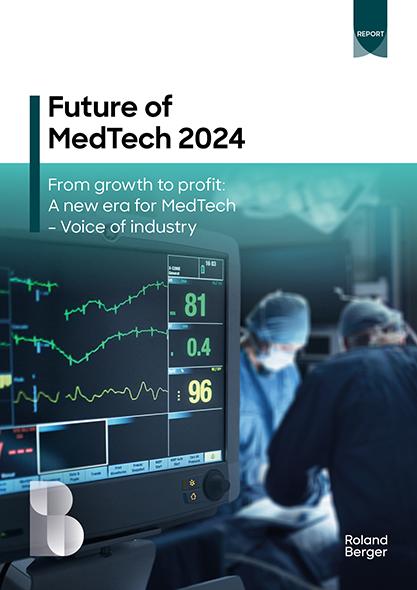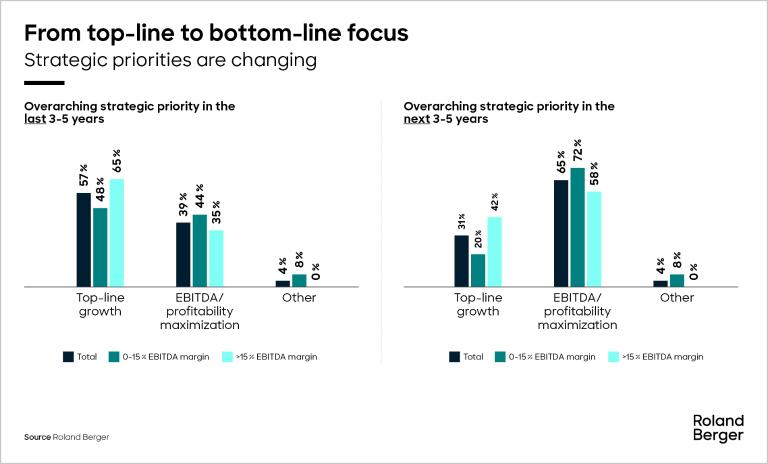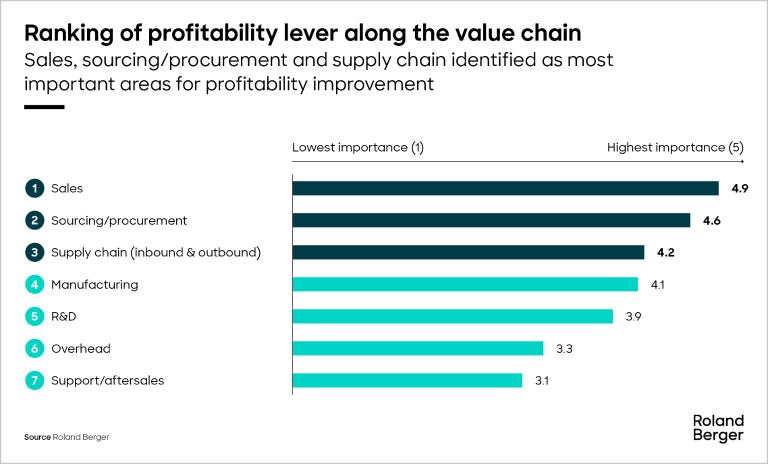MedTech saw profit dip in 2022-23; European firms hit by supply chain disruptions, rising costs, and inflation. To recover, prioritize operational excellence, embrace ESG for long-term viability.


Future of MedTech 2024
By Peter Magunia and Christoph Schmid
From growth to profit: A new era for MedTech - Voice of industry
MedTech (medical technology) companies are seeing their profit margins eaten away over time. How can they reverse this trend? The Roland Berger Future of MedTech Study 2024 indicates a strategic shift from the historic prioritization of top-line growth as the main driver of value creation to a focus on profit maximization. Executives further highlight the criticality of a general simplification via portfolio streamlining and a concentration on core markets. We examine how industry insiders view the current situation in MedTech, what steps they can take to unlock further potential and what technologies help to realize that potential. Overall, senior executives rank sales, sourcing/procurement and supply chain as the key areas for performance improvement along the entire value chain.

"In the MedTech industry, there's a notable strategic shift towards prioritizing profitability over top-line growth, emphasizing the need for companies to stabilize core operations and reassess strategic priorities amid evolving business landscapes."
A shift of focus
How are MedTech companies managing to stay competitive in today's challenging business environment? A macroeconomic climate marked by high inflation, constrained capital markets, uncertain supply and growing geopolitical tensions – factors we discussed in detail in our 2023 Global MedTech Study – are putting hitherto unseen pressure on their margins. Slowly but surely, profitability is declining. In response, many players are making a strategic shift away from growing revenues and towards boosting profitability. In a nutshell, they are focusing their attention on the bottom line rather than the top line.
Clear evidence for this is found in the responses to our survey of around 600 executives in C-level and senior leadership positions in firms across the MedTech industry, carried out for the purpose of this year's Future of MedTech study. Around 65 percent of companies stated that they were planning to prioritize EBITDA/profit maximization over the next three to five years – an increase of around three-quarters compared to previous years. In contrast to that, just 31 percent said they would be targeting top-line growth as their main strategic priority in the coming years, roughly half the proportion that did so in previous years.
"Efficient technology implementation across the value chain is critical for MedTech firms to boost effectiveness and profitability."
How to boost profitability
Respondents also told us how they were going to realize profit maximization. Their preferred strategies here are to streamline the product portfolio (rated 3.7 out of 5 in terms of importance) and focus on core markets (3.6). Strategies such as vertical or horizontal integration were less popular. The data reveals a shift of strategic focus from increasing the company's share of existing markets and entering new ones to concentrating on core market positions and capabilities.
Where do the best opportunities for enhancing profitability lie in the value chain? Respondents considered three areas to be the most important: sales, sourcing/procurement and supply chain. MedTech companies' sales concept should be reoriented towards a less people-centric approach and the full possibilities of automation should be exploited. In the area of sourcing/procurement, streamlining the supplier landscape and bundling sourced components, as well as reviewing the quality of required product components, were considered the important areas for optimization. In supply chain, automation and warehouse outsourcing were the new priorities, including the introduction of alternative models with guaranteed supply volumes. It should be noted that the importance of a specific lever according to respondents does not always fully correspond to the margin improvement potential that the lever can deliver – for reasons that we elucidate in the full report.
The power of technology
Our respondents said that technology and innovation were key factors in boosting profitability. Artificial intelligence (AI) and machine learning can be revolutionary when it comes to managing supply chains, for instance. In manufacturing, robotic process automation (RPA) and digital remote collaboration in sales are similarly powerful tools. For example, RPA can have a huge impact on high-volume processes, such as dealing with purchase orders and invoices. It can also be a game changer in high-risk and data validation processes, helping manufacturers meet the strict quality requirements imposed by regulators.
Turning the tide
We have identified key steps for MedTech companies to turn the tide on declining profit margins. MedTech firms should reassess strategic priorities, optimize the different levers along the value chain and invest in new technologies. Hence, leaders in the MedTech sector must take charge by identifying high-value use cases and evaluate the strategic impact of these cases on their core business.
Register now to access the full publication and learn more about next steps in the MedTech industry to unlock further potential.








